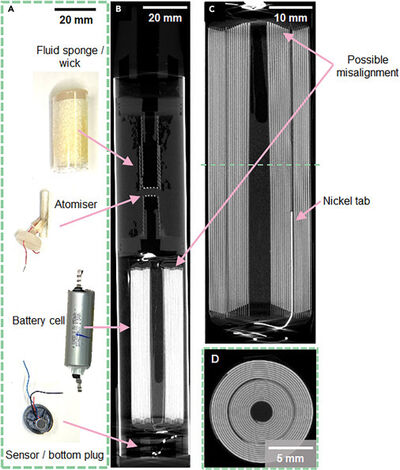Single-use e-cigarettes : The environmental impact of disposable vapes: A growing threat to waste management

It’s time to talk trash—specifically, the kind that explodes, pollutes, and endangers the principles of a circular economy. Disposable e-cigarettes, or “vapes,” are the latest in a long line of single-use products causing havoc not just for our health but also for waste management professionals and the planet itself. Despite their sleek design and convenience, these tiny gadgets pack a dangerous punch—particularly due to the lithium batteries sealed within.
A fiery threat in waste facilities
In Austria, the call to ban disposable e-cigarettes is getting louder. The Association of Austrian Waste Management Companies (VOEB) and the Working Group of Austrian Waste Management Associations (ARGE AWV) are urging legislators to include a ban in the upcoming amendment of the Tobacco and Nicotine Addiction Act. Their plea follows alarming incidents like the recent inferno at a waste management site in Schönau, where a defective battery cell triggered a fire that required 120 firefighters to control.
Such fires aren’t rare. Every day, waste management facilities across Austria (and beyond) battle flames sparked by damaged lithium batteries—batteries often found in improperly discarded disposable vapes. Despite clear regulations that these devices must be handed in at specific collection points or retail outlets, many end up in regular household trash, where they become ticking time bombs.
>>> The Hidden peril of lithium-ion batteries: A call for responsible disposal
Ecological cost: From resource waste to pollution
From a sustainability perspective, disposable vapes are doubly problematic. Not only do they contain flammable components, but they also squander valuable raw materials. Each discarded device represents a loss of critical metals like lithium, cobalt, and nickel—resources that are already under global pressure.
“Against the backdrop of increasingly scarce resources, disposable e-cigarettes should be seen as an environmental sin,” says Anton Kasser, President of ARGE AWV. “If these products also pose an acute fire hazard, as is the case with disposable vapes, then everything clearly speaks in favour of a nationwide ban.”
The devices fly in the face of circular economy principles, where the aim is to reuse, recycle, and extend the life of materials—not seal them inside a product designed to be tossed after a few uses.
>>> Li-ion Batteries as Fire Hazards in Waste Management Facilities

A growing global movement
Austria isn’t alone in this fight. Several European countries are already taking decisive steps. Belgium has implemented a total ban on disposable vapes as of January 2025. France followed suit in February, and the UK will enforce its own ban starting June 2025. According to a UK study, five million disposable vapes are discarded every week—an overwhelming strain on waste systems and the environment.
Momentum is building at the EU level too. Waste industry associations are pushing for a union-wide ban, citing the same concerns: fire risk, resource loss, and environmental damage. They argue that just like single-use plastic cutlery and straws, disposable vapes should be phased out under the EU’s regulatory framework on waste and sustainability.
Are more disposable products still justifiable?
At a time when the climate crisis is accelerating and resource scarcity is a growing concern, one has to wonder: do we really need more disposable products? The convenience they offer comes at a steep environmental and operational cost. And for waste professionals—already navigating increasingly complex recycling streams—the addition of hazardous, hard-to-recycle items like disposable vapes is both dangerous and unnecessary.
The issue isn’t just about poor disposal habits. It’s about a product designed without consideration for its end-of-life journey. In the words of Gabriele Jüly, President of VOEB: “The increase in products containing lithium batteries is jeopardising the existence of every single waste and resource management company. This also includes disposable vapes, which are simply dangerous polluters.”
Disposable vapes and the Ecodesign paradox: Why are they still allowed?
When viewed through the lens of the Ecodesign Regulation, the widespread availability of disposable vapes on the European market is nothing short of paradoxical. The Ecodesign framework—established to ensure products are designed with resource efficiency, reparability, and recyclability in mind—seems fundamentally at odds with the existence of a product that is, by definition, disposable.
Disposable vapes are the antithesis of eco-design principles:
- They’re not designed to be repaired or refilled.
- The lithium-ion batteries are non-removable in most cases.
- They contain mixed materials (plastic, metal, electronics, nicotine residues), making them difficult and often uneconomical to recycle.
- They are marketed for single-use, encouraging a throwaway mindset that contradicts the EU’s push for a circular economy.
So why are they still legal?
There are several reasons why disposable e-cigarettes have slipped through the cracks:
- Regulatory gaps between product categories:
The Ecodesign Directive (soon to become the Ecodesign for Sustainable Products Regulation or ESPR) primarily targets energy-related products like home appliances, lighting, and electronics. Vapes, while electronic in nature, have historically fallen under tobacco or health product regulation, not environmental product design. This has allowed them to evade strict eco-design scrutiny.
- Lack of specific standards:
There are currently no ecodesign criteria specifically tailored for vaping products. Without these in place, there is no legal mechanism within the Ecodesign Regulation to prohibit products like disposables—even if they clearly violate its spirit.
- Slow regulatory response to fast-moving markets:
The vape industry has exploded in popularity faster than regulators could adapt. As with other emerging consumer tech products, there’s often a lag between market adoption and the introduction of targeted environmental standards.
- Industry pushback and lobbying:
The tobacco and vaping industries are powerful and well-resourced. They’ve successfully delayed or watered down regulation in many countries by emphasising consumer freedom, harm reduction compared to cigarettes, and the economic benefits of the sector.
Time for coherence in sustainability policy
This regulatory inconsistency undermines the EU’s own green goals. You can’t claim to champion the circular economy and still allow a product that combines hazardous waste with non-recyclable design to be mass-produced and sold across Europe.
To resolve this, disposable vapes need to be brought under the scope of the Ecodesign Regulation or similar EU-wide legislation on sustainable products. They should be:
- Subject to design-for-disassembly requirements (e.g. removable batteries),
- Banned unless they can meet stringent repairability and recyclability standards, or
- Phased out entirely, as some EU nations are already doing.
As the new Ecodesign for Sustainable Products Regulation gains force, there is a critical opportunity for the EU to close this loophole.


